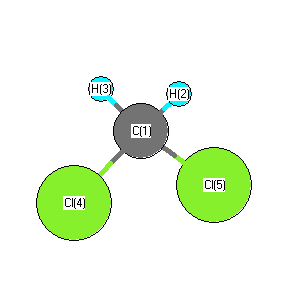Vibrational Frequencies calculated at PBEPBEultrafine/cc-pV(T+d)Z
| Mode Number |
Symmetry |
Frequency
(cm-1) |
Scaled Frequency
(cm-1) |
IR Intensities
(km mol-1) |
Raman Act
(Å4/u) |
Dep P |
Dep U |
|---|
| 1 |
A1 |
272 |
272 |
0.39 |
6.46 |
0.51 |
0.67 |
| 2 |
A1 |
694 |
694 |
10.82 |
11.21 |
0.08 |
0.15 |
| 3 |
A1 |
1406 |
1406 |
0.13 |
8.29 |
0.75 |
0.86 |
| 4 |
A1 |
3040 |
3040 |
7.73 |
106.42 |
0.05 |
0.10 |
| 5 |
A2 |
1129 |
1129 |
0.00 |
4.61 |
0.75 |
0.86 |
| 6 |
B1 |
872 |
872 |
1.79 |
1.44 |
0.75 |
0.86 |
| 7 |
B1 |
3113 |
3113 |
0.03 |
53.78 |
0.75 |
0.86 |
| 8 |
B2 |
706 |
706 |
153.59 |
2.92 |
0.75 |
0.86 |
| 9 |
B2 |
1235 |
1235 |
33.11 |
1.69 |
0.75 |
0.86 |
Unscaled Zero Point Vibrational Energy (zpe) 6233.9 cm
-1
Scaled (by 1) Zero Point Vibrational Energy (zpe) 6233.9 cm
-1
See section
III.C.1 List or set vibrational scaling factors
to change the scale factors used here.
See section
III.C.2
Calculate a vibrational scaling factor for a given set of molecules
to determine the least squares best scaling factor.
Charges, Dipole, Quadrupole and Polarizability
Charges from optimized geometry at PBEPBEultrafine/cc-pV(T+d)Z
Charges (e)
| Number |
Element |
Mulliken |
CHELPG |
AIM |
ESP |
| 1 |
C |
-0.065 |
|
|
|
| 2 |
H |
0.138 |
|
|
|
| 3 |
H |
0.138 |
|
|
|
| 4 |
Cl |
-0.105 |
|
|
|
| 5 |
Cl |
-0.105 |
|
|
|
Electric dipole moments
Electric dipole components in Debye
(What's a Debye? See section
VII.A.3)
| |
x |
y |
z |
Total |
| |
0.000 |
0.000 |
1.605 |
1.605 |
| CHELPG |
|
|
|
|
| AIM |
|
|
|
|
| ESP |
|
|
|
|
Electric Quadrupole moment
Quadrupole components in D Å
| Primitive |
|---|
| | x | y | z |
|---|
| x |
-31.260 |
0.000 |
0.000 |
| y |
0.000 |
-33.579 |
0.000 |
| z |
0.000 |
0.000 |
-29.721 |
|
| Traceless |
|---|
| | x | y | z |
|---|
| x |
0.390 |
0.000 |
0.000 |
| y |
0.000 |
-3.089 |
0.000 |
| z |
0.000 |
0.000 |
2.699 |
|
| Polar |
|---|
| 3z2-r2 | 5.398 |
|---|
| x2-y2 | 2.319 |
|---|
| xy | 0.000 |
|---|
| xz | 0.000 |
|---|
| yz | 0.000 |
|---|
|
Polarizabilities
Components of the polarizability tensor.
Units are
Å
3 (Angstrom cubed)
Change units.
| |
x |
y |
z |
| x |
3.979 |
0.000 |
0.000 |
| y |
0.000 |
7.491 |
0.000 |
| z |
0.000 |
0.000 |
4.838 |
<r2> (average value of r
2) Å
2
| <r2> |
105.359 |
| (<r2>)1/2 |
10.264 |
